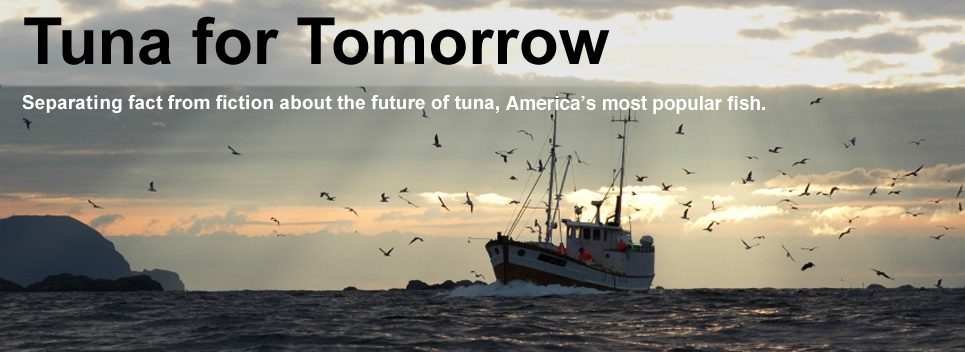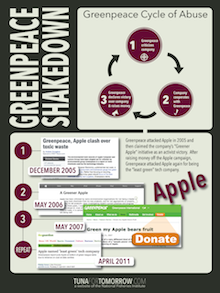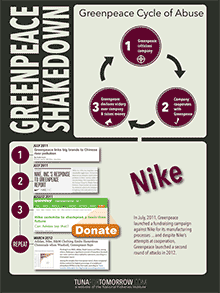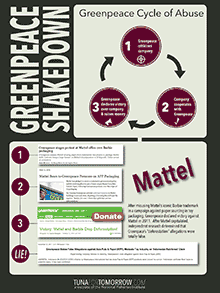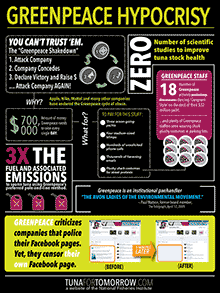In the Huffington Post, Aaron Gray-Block, a Greenpeace ŌĆ£media specialist,ŌĆØ shares his experiences sailing the Indian Ocean on the $37-million Greenpeace yacht, Rainbow Warrior III. In between port calls in Mauritius, the Maldives and other resort communities, Mr. Gray-Block tells us about artisanal fishermen catching tuna using their traditional pole-and-line method without fish aggregating devices (FADs). ŌĆ£Sustainable fishing at its best,ŌĆØ he says.
Greenpeace prefers this fishing method to the far more common purse seining for a variety of self-serving reasons. But the bottom line is that it is impractical and unable to meet worldwide consumer demand for nutritious and affordable canned tuna.
By GreenpeaceŌĆÖs own admission, pole and line costs more and retailers like Sainsbury’s, M&S, and Waitrose have discovered sustainably ŌĆō minded consumers need a monetary incentive to buy tuna caught using this artisanal fishing method. Is this the right model for American retailers when there are equally sustainable, more reliable and more affordable ways to provide tuna to its customers?ŌĆØ
Of course, Greenpeace overlooks some of the other ŌĆ£premiumsŌĆØ involved with pole-and-line fishing. For instance, thereŌĆÖs the fuel premium. ThatŌĆÖs the extra amount of fuel consumed by fleets of small boats searching the high seas for migratory tuna.┬ĀAccording to a study by the School for Resource and Environmental Studies at Dalhousie University in Canada, fishing with purse seine gear was found to burn on average 369 liters of fuel per ton of tuna caught. Pole and line burns four times as much fuel (1490 liters) for the same amount of fish.
Then there is the carbon premium. ThatŌĆÖs the extra tons of carbon emissions that would be the consequence of a global pole-and-line fleet.
ThereŌĆÖs also the inefficiency premium. According to the International Seafood Sustainability Foundation (ISSF), a typical pole-and-line fishing boat requires a crew of 30 or more to bring in a fraction of the catch that a purse seiner with 18 professionals aboard is capable of.
ThereŌĆÖs the bait premium because pole and line fishermen need lots more small fish harvested in nets that they use to lure and catch the bigger fish.
And for all we know there may even be a FAD premium because pole-and-line fishing requires many more boats ŌĆō fishing boats, bait boats, transport boats ŌĆō all of which act as fish attracters, according to the U.N.ŌĆÖs Food and Agriculture Organization.
Science shows that there is no perfect tuna fishing method. They all have their costs and benefits. The best and most sustainable approach is a balanced one that includes pole and line as well as purse seining with FADs and other methods. ThatŌĆÖs what the responsible adults ŌĆō conservationists, researchers, commercial fishermen and others with a true stake in tuna sustainability ŌĆō have been saying for years.
ItŌĆÖs not as exciting as sailing the Indian Ocean on a yacht filled with passionate young men and women like Aaron Gray-Block. But itŌĆÖs what will truly make a difference to the environment.
In the meantime, people should be free to buy the products they want and can afford — whether thatŌĆÖs commercially sourced tuna in their local supermarket or artisanal tuna caught by hand in the balmy Maldives Islands.


